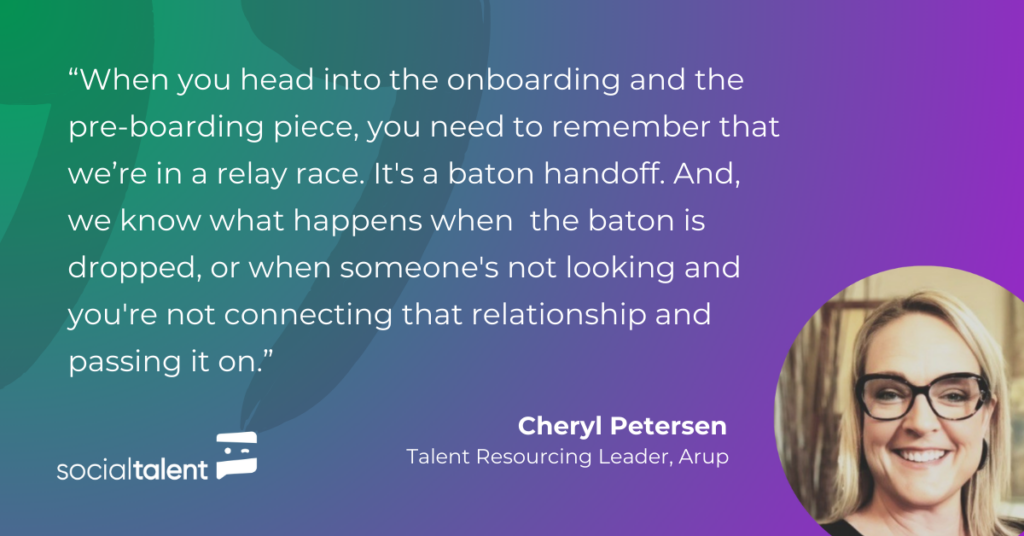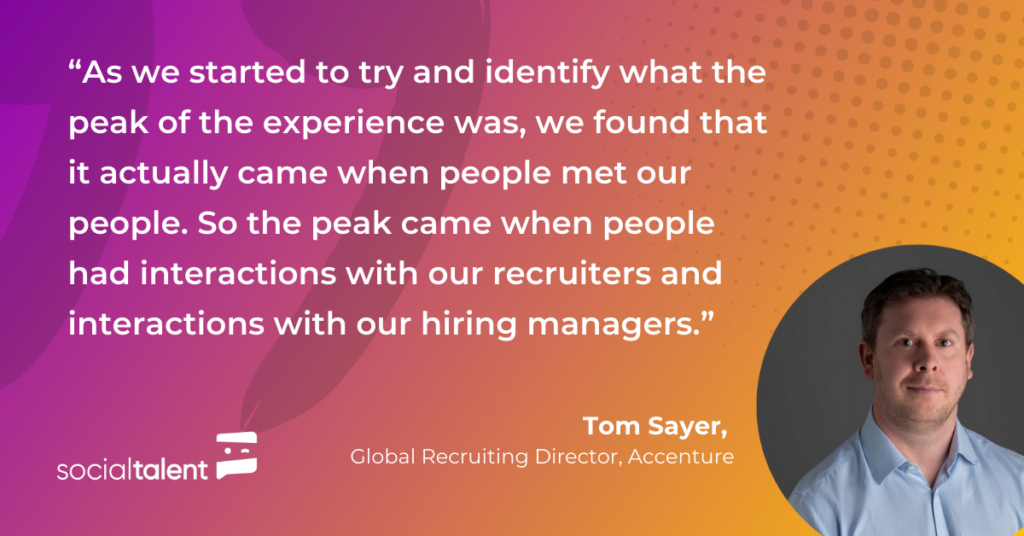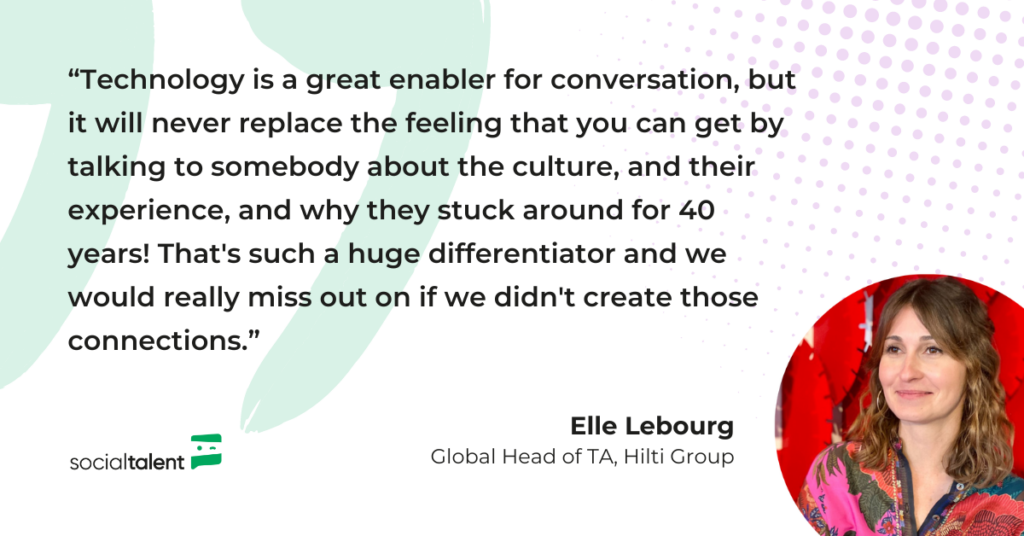
By David Deady
The future of candidate experience is evolving rapidly, as highlighted in our three thought-provoking panels during SocialTalent Live. Industry leaders explored the challenges and opportunities that shape the recruitment landscape, emphasizing the importance of balancing automation with personalization. From providing timely feedback to integrating data-driven insights, organizations are rethinking their approaches to enhance the candidate journey and align it with their employer and consumer brands. Through insightful discussions, they showcased how human interaction remains a critical differentiator, even in an increasingly tech-driven world. Let’s get into it!
Speakers:
- Kevin W. Grossman, VP of Research, ERE Media
- Cheryl Petersen, Regional Talent Resourcing Leader, Arup
- Tom Sayer, Global Recruiting Director, Accenture
- Elle Lebourg, Global Head of Talent Acquisition, Hilti Group
- Gui Neves, Global Talent Acquisition Sourcing & Solutions Manager, Nestlé
Watch a full recording of the event:
Panel 1: What Drives Positive Candidate Experience?
The first panel of SocialTalent Live, featuring Kevin Grossman and Cheryl Petersen, focused on the evolving challenges in recruitment and the importance of enhancing the candidate experience. Kevin opened the discussion by highlighting the difficulties recruiters face today, noting that candidate frustration and resentment have reached unprecedented levels. He attributed this to thinner recruitment teams and overwhelming candidate volumes. “Teams are leaner, they’re struggling to respond to every single candidate,” he said. “It’s an uphill battle for any company hiring at scale.”
Cheryl Petersen, sharing her experience, explained the key improvements Arup has made in the last 6 to 12 months to enhance the candidate experience, despite these challenges. One of the primary areas they addressed was the balance between automation and personalization. Cheryl noted, “It’s a balance of listening and hearing what candidates say about the process being impersonal,” referring to how her team handled feedback on pre-recorded video interviews. To address this, her team began communicating more openly about the use of these interviews, framing them as a tool to allow more candidates the chance to engage with the company.
Cheryl also emphasized the importance of providing timely feedback, a key frustration for candidates. Her team introduced interview debriefs within 24 hours of an interview, ensuring candidates knew where they stood in the process. “Candidates wanted to get more immediate feedback and know where they were at in the process,” Cheryl explained. By speeding up the feedback loop, they were able to reduce some of the frustration candidates feel during long waiting periods.
Kevin pointed out that often, no matter the improvements made, some candidates will always feel disappointed when they don’t get the job. He explained that there are two distinct groups in ERE’s research: the candidates who get hired and feel positive about their experience, and everyone else, whose experience is often negative regardless of how fair the process seemed. “The people who got the job are the only happy customers at the end of the day,” he stated. Petersen agreed and highlighted the importance of handling rejections with care. Her team has focused on keeping candidates engaged, even after rejection, by encouraging them to join talent communities and sending recruitment marketing newsletters to maintain a connection.

The conversation then shifted to the specific challenge of pre-recorded video interviews, particularly for campus recruitment, where high volumes of applications are common. While candidates initially resisted, Cheryl’s team worked to provide context. “We explain to them why we do the pre-recorded video interview… and how they can help prepare the candidates,” she said. This transparency helped reduce backlash, as candidates better understood the reasoning behind the process.
In the later stages of the candidate journey, Petersen stressed the importance of pre-boarding and onboarding, likening it to a “baton handoff” in a relay race. She emphasized the need for strong communication between recruiters and hiring managers to ensure new hires feel welcomed and engaged. Simple acts like a hiring manager reaching out before day one, she noted, can make a huge difference in retention and early engagement. “We were that initial relationship to the company—we don’t want them to lose that.”
Kevin concluded by underscoring the role of feedback and transparency in making a lasting impression on candidates. “Communication and feedback are always perennial differentiators every year in our research,” he said, emphasizing that companies that prioritize these areas will stand out in the increasingly competitive recruitment landscape.
Fireside Chat: With Tom Sayer, Global Recruiting Director at Accenture
In the second section of our SocialTalent Live event, Johnny Campbell sat down with Tom Sayer, Global Recruiting Director at Accenture, to discuss the company’s large-scale hiring efforts and the role of data in improving candidate experience. Campbell opened the conversation by highlighting Accenture’s impressive hiring scale, noting that the company recruits around 200,000 people each year. Tom provided context, explaining that Accenture, with over 730,000 employees, hires for a vast range of technical and consulting roles, and the volume of applications—about 5 million annually—poses unique challenges.
Tom then detailed how Accenture has approached the task of gathering and utilizing candidate feedback. “We realized we weren’t capturing actionable insights,” Sayer said, explaining that the initial method of sending candidates a survey two weeks after their recruitment process concluded wasn’t yielding valuable data. “It was all after the fact,” he explained, leading to skewed data since the survey responses primarily came from successful candidates.
To improve the quality of the insights, Sayer’s team reimagined the feedback process, adopting a more granular, “pulsing” approach. This new method surveys candidates at multiple stages of their journey, from the point of application to final disposition, rather than waiting until the end of the process. “We started pulsing candidates throughout the journey to try and get more real-time insights into how they were feeling,” Tom said. This shift has helped them gather more timely and accurate feedback, enabling them to address issues as they arise.
One unexpected insight from the data was that candidates were generally satisfied with the application process, which Tom admitted surprised his team. He hypothesized that surveying candidates in the moment might have influenced this perception, but overall, the real standout in the feedback was the importance of human interaction. “The peak came when people met our people,” Sayer noted, emphasizing that candidates had the most positive experiences when they interacted with recruiters and hiring managers. This finding reinforced the idea that while technology can facilitate the recruitment process, the human element remains crucial.

Tom and Johnny discussed the balance between automation and human interaction, particularly given Accenture’s vast scale. Sayer explained that while automation plays a critical role in handling high volumes of applications, it’s essential to tailor the experience based on the type of role being recruited for. “When it comes to managing director appointments, where you expect more of a white-glove experience, you need to dial things back,” he said, highlighting the need for more personalized engagement in senior-level hires.
The conversation then shifted to feedback, which Tom described as Accenture’s “number one candidate experience issue.” To address this, Accenture has implemented training for recruiters and hiring managers on the importance of timely and high-quality feedback. Tom also pointed to the potential of emerging technologies to streamline the feedback process, such as tools that can summarize interview notes and provide insights, making it easier for interviewers to offer meaningful feedback quickly.
Summing up, Tom underscored the importance of the human element in recruitment. “If we really want to optimize the experience, we need to lean into how we enable our people,” he said, noting that human interactions remain the most memorable and impactful part of the candidate experience. Johnny echoed this sentiment, concluding that while technology is essential for scaling recruitment, it’s the people behind the process who truly make a difference.
Panel 2: The Connection Between Employer and Consumer Brand
In the final panel of SocialTalent Live, Johnny Campbell moderated a discussion with Elle Lebourg, Global Head of Talent Acquisition at Hilti Group, and Gui Neves, Global Talent Acquisition Sourcing & Solutions Manager at Nestlé, focusing on the connection between employer and consumer brand. The conversation centered on how companies can align these two aspects to improve the candidate experience.
Elle introduced Hilti, a company focused on improving the construction industry, and emphasized how critical it is for Hilti to provide a premium, high-touch experience not only to customers but also to candidates. “We want to leave our candidates just better than how they started interacting with us, wherever that looks like in the process,” she explained. Hilti, while not as globally recognized as some of its peers, prioritizes ensuring that its candidates experience the same personalized service that the company provides to its customers.

Gui, representing Nestlé, discussed the challenge of maintaining consistent branding across different regions and products, given the company’s scale. “We receive more than 6 million applications a year,” he said, highlighting the challenge of connecting with so many candidates. Like Hilti, Nestlé strives to maintain alignment between their employer and consumer brand by ensuring that candidates experience the company’s core values at every touchpoint, even when they’re not hired. Gui mentioned, “We have to ensure that they can feel our Nestlé values in all those connection points, even in the way they are rejected.”
Elle emphasized the importance of customizing the candidate experience to reflect the unique needs of different markets and candidate personas. Hilti, she explained, doesn’t rely on a “one-size-fits-all” approach, as different regions have varying levels of brand awareness. “It’s a lot of legwork, but it’s worth it,” she said, explaining that her team has started to focus on persona-based strategies to target specific candidate types and create a more personalized and memorable experience.
The discussion also touched on the role of technology in enhancing the candidate experience. Both Gui and Elle agreed that while technology is a critical enabler, it cannot replace human interaction. Elle stated, “As soon as we can get somebody talking to a Hilti person, they get it—they fall in love with the company.” Gui echoed this sentiment, highlighting that although Nestlé leverages AI and chatbots to handle high volumes, human interaction remains essential, especially in delivering personalized experiences and conveying the company’s values.
Together, Gui and Elle also explored how their companies measure the effectiveness of their candidate experience strategies. Gui shared that Nestlé has been piloting a program that provides candidates with training resources, even if they aren’t hired, to leave a positive impression. “We’re giving them something else, beyond just feedback,” he said.
Elle spoke about Hilti’s efforts to build talent communities, which offer candidates valuable touchpoints with the company, even if they aren’t hired immediately. “It’s about giving people quality touchpoints,” she said, emphasizing the importance of consistency and authenticity in maintaining candidate engagement.
When asked about the key drivers of a successful global candidate experience, Gui highlighted the importance of consistency in messaging. “Telling the candidates the story and how we are all connected with those different companies and brands with the same purpose and values is the number one point for engagement,” he said.
The panel concluded by reinforcing the idea that while technology is essential for scaling recruitment processes, it is the human touch and consistent, value-driven communication that truly elevates the candidate experience. Both Hilti and Nestlé are committed to creating meaningful, personalized interactions that align with their consumer brands and leave a lasting positive impact on candidates.
Conclusion
SocialTalent Live event provided a comprehensive look into the future of candidate experience, highlighting the importance of human interaction, feedback, and transparency. While automation and technology play critical roles in managing recruitment at scale, the consensus among experts was clear: personalized engagement is what truly leaves a lasting impression on candidates. As organizations strive to align their employer and consumer brands, they must prioritize communication and consistent value-driven experiences. Ultimately, the future of candidate experience will be shaped by how well companies balance technological efficiency with meaningful, human-centered interactions.


